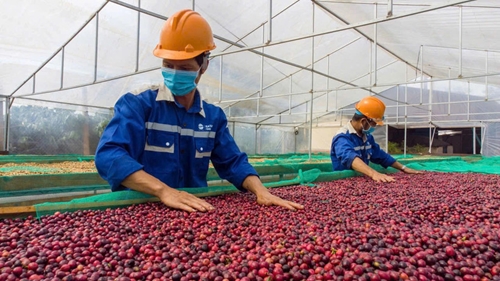Exports stay on the rise despite tariff pressures
Among the seven countries surveyed by S&P Global in July, Vietnam led with a PMI of 52.4, well above the ASEAN average of 50.1. New export orders rose for the fourth straight month, reaching their fastest growth rate since November 2024.
This positive and surprising sign comes amid continued concerns over the reciprocal tariffs from the U.S., a key export market.
    |
 |
|
Staple agricultural exports such as pepper and coffee remain resilient, relatively insulated from the U.S. tariffs. (Photo: thanhnien.vn) |
Pham Sy Hoai, Vice President and General Secretary of the Vietnam Timber and Forest Product Association (VIFORES), noted that despite heavy impacts of the U.S. reciprocal tariffs and trade defense measures, timber and wood product exports hit 9.6 billion USD by the end of July, up 7.9% year-on-year.
The sector is projected to earn over 7 billion USD in the final five months of 2025, bringing the year’s total to around 17 billion USD, he said.
Staple agricultural exports such as pepper and coffee remain resilient, relatively insulated from the U.S. tariffs. Phan Minh Thong, Chairman of Phuc Sinh Group, highlighted that these goods continue to perform well, supported by strong global demand and rising prices.
Phuc Sinh’s export turnover reached 305 million USD in the first ten months of the 2024–2025 financial year (ending in September 30, 2025), marking a year-on-year increase of nearly 25%. Pepper prices tripled while coffee prices doubled, significantly boosting revenue.
Vietnam’s aquatic exports reached 6.22 billion USD in the first seven months of 2025, a 17.2% increase from the same period last year, according to the Vietnam Association of Seafood Exporters and Producers (VASEP). Exports to the U.S. rose 10.4%, while those to China soared 42.6% to 1.33 billion USD.
China’s renewed large-scale imports, particularly of shrimp and squid, have opened major opportunities, especially ahead of the U.S. tariff imposition in August. Vietnamese firms have responded with aggressive market diversification, strategic use of multilateral free trade agreements, and agile supply chain adjustments.
Boosting U.S. imports to balance trade
In response to U.S. trade actions, Vietnamese timber firms have stepped up imports of American round and sawn timber. In 2024, Vietnam purchased 320 million USD in U.S. wood materials. During the first seven months of this year, imports already reached 321 million USD, surpassing the previous year’s total.
This shows Vietnam’s goodwill in narrowing the trade surplus and supporting American timber producers, said Hoai. If export conditions remain stable, imports from the U.S. are expected to keep rising through year-end, he held.
He added that Vietnamese furniture exporters remain hopeful for a fair and suitable tariff framework that avoids market disruption and protects American consumer access to Vietnamese products.
The textile and garment industry has also diversified its raw material sources. In the first five months of 2025, Vietnam imported nearly 950,000 tons of cotton worth over 1.6 billion USD, up 27% in volume and 8% in value from the same period in 2024. The U.S. remained Vietnam’s top supplier, accounting for 48% of total imports. Imports from the U.S. reached 455,000 tons worth 800 million USD, shooting up 116% in volume and 79% in value. Vietnam is now the third-largest importer of U.S. cotton, after China and Pakistan.
Vietnam’s coffee exports to the U.S. remain modest as the E.U. is the primary market. Meanwhile, the country dominates global pepper shipments, with about 50% of global market share. It also imports pepper from Indonesia for re-export, reinforcing its critical role in global supply chains.
While the U.S. imposed 20% tariffs on Vietnamese products, similar to Indonesia’s rate and well below Brazil’s 50%, exporters are optimistic.
Pepper and coffee are essentials, and even at higher prices, demand remains strong, said Thong. He noted that a decade ago, a cup of coffee costed 1 USD. Today, it’s even 14 or 15 USD in some places, and people still drink it.
He added that Vietnam’s agricultural exports face minimal direct competition from U.S. producers, reducing the likelihood of trade defense measures such as anti-dumping investigations.
Source: VNA